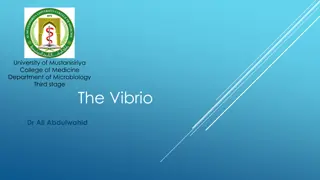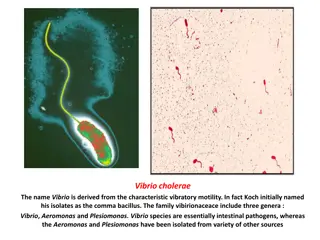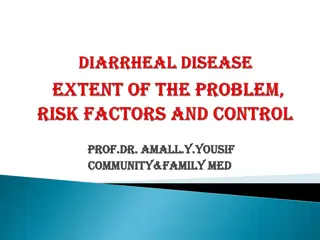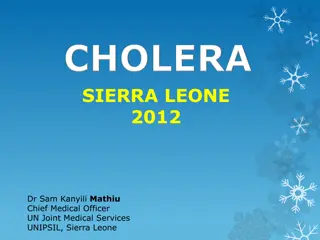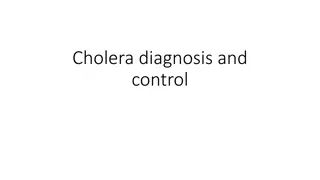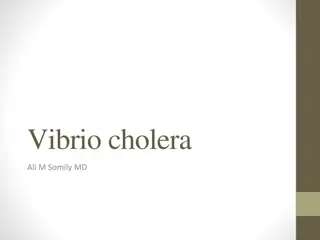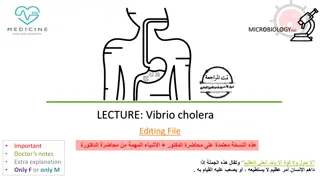Understanding Vibrio and Related Organisms in Medical Bacteriology
Vibrio, Aeromonas, and Plesiomonas are gram-negative bacilli commonly found in water sources, causing gastrointestinal diseases. They exhibit similarities to Enterobacteriaceae but with distinct characteristics such as polar flagella and being oxidase-positive. Vibrios like V. cholerae are crucial h
1 views • 25 slides
Understanding Vibrio Cholerae: Biology and Impact on Human Health
Vibrio cholerae is a significant bacterium responsible for causing cholera, a life-threatening diarrheal disease. With over 35 species in the Vibrio genus, only a few can infect humans. Vibrio cholerae is a Gram-negative, curved aerobic rod that produces an enterotoxin leading to cholera. Understand
0 views • 23 slides
Overview of Vibrio cholerae: Characteristics and Identification
Vibrio cholerae is a gram-negative, curved rod bacterium known for causing cholera. Its distinctive features include polar flagellum motility, oxidase-positive nature, and resistance to inhibitory substances. Various culture media are used for its isolation and growth, such as transport, routine, an
0 views • 8 slides
Understanding Water-borne Diseases and Pathogens
Drinking contaminated water can lead to water-borne diseases, causing millions of deaths annually, especially in developing countries. Potable water is essential for health and development, as water-related diseases arise from inadequate water quality and poor sanitation practices. Various pathogens
1 views • 28 slides
Understanding Feco-Oral Diseases and Diarrhea Transmission
Feco-oral diseases, primarily transmitted through the fecal-oral route, remain a significant global health concern, especially affecting children under 5 and the elderly. Diarrhea, characterized by WHO as three or more watery stools in 24 hours, poses a substantial burden, with infectious agents cau
0 views • 46 slides
Understanding Cholera - Causes, Symptoms, and Prevention Strategies
Cholera is an acute intestinal infection caused by the bacterium Vibrio cholerae. It leads to watery diarrhea due to the production of a potent enterotoxin. The disease has two distinct life cycles - one in the environment and one in humans. Factors such as access to safe water and sanitation play a
0 views • 21 slides
Cholera Diagnosis and Control Methods Overview
Cholera diagnosis involves various laboratory tests such as specimen analysis, smears, and cultures. Slide agglutination tests and the oxidase test can also aid in the identification of Vibrio cholerae bacteria. Understanding these diagnostic methods is crucial for effective control and management o
0 views • 14 slides
Understanding Cholera: Epidemiology, Microbiology, Clinical Features, and Management
Cholera is a water-borne disease caused by Vibrio cholera, characterized by severe diarrhea. Learn about its history, microbiological characteristics, pathogenesis, clinical features, laboratory diagnosis, management, and outbreak control. Discover the epidemiology, including major outbreaks and tra
0 views • 19 slides
Understanding Cholera: Epidemiology, Microbiology, and Clinical Features
Cholera is a life-threatening intestinal infection caused by Vibrio cholera bacteria. The disease is water-borne and prevalent in regions with poor sanitation. Learn about the epidemiology, microbiological characteristics, pathogenesis, clinical features, and management of cholera from this comprehe
0 views • 12 slides

